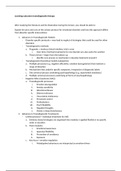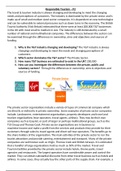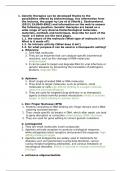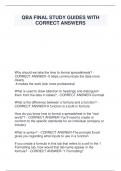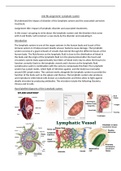Learning outcomes transdiagnostic therapy
After studying the literature and the illustration during the lecture, you should be able to:
Explain the pros and cons of the unitary protocol for emotional disorders and how this approach differs
from disorder specific interventions
1. Advances in Transdiagnostic Models:
- Disorder-specific protocols = may lead to neglect of strategies that could be used for other
disorders
- Transdiagnostic methods:
a. Pragmatic = involves clinical intuition, trial n error
i. Over time, find that treatments for one disorder are also useful for another
b. Theory-driven = begin from the bottom up
i. Identify core process or mechanism n develop treatment around it
- Transdiagnostic theoretical models (categories):
a. Multiple processes (e.g. negative affectivity, emotion dysregularion) that maintain a
range of disorders
b. Mechanisms that underlie specific symptoms, irrespective of diagnostic labels
c. One universal process underlying psychopathology (e.g. experiential avoidance)
d. Multiple universal processes underlying all forms of psychopathology
- Negative Affect Syndrome (NAS):
a. Transdiagnostic processes:
i. Emotion dysregulation
ii. Anxiety sensitivity
iii. Attentional biases
iv. Distress tolerance
v. Uncertainty intolerance
vi. Perceived control
vii. Perfectionism
viii. Psych flexibility
ix. Negative thoughts
x. Shame n sleep disturbances
2. Advances in Transdiagnostic Treatments:
- Unified protocol = individual treatment for NAS
a. Evidence-based strategies are organized into modules n applied flexibly w no specific
order or duration
b. Main modules:
i. Emotional awareness
ii. Appraisal flexibility
iii. Prevention of avoidance
iv. Exposure
c. Key focus = emotion regulation
i. Maladaptive behaviours are interpreted as emotion-driven
, ii. Treatment as emotion-focused CBT
d. Benefits:
i. Improved QoL n temperament factors (neuroticism/extraversion)
ii. Reduced primary symptoms
e. Predictors of outcome:
i. Perceived control n readiness for change
ii. Important to change relationship b/n negative emotions n frequency of negative
emotions
iii. Focus on fear of emotions and anxiety sensitivity
- Transdiagnostic group CBT:
a. Most evidence based group protocol
b. 12 weekly, 2hr sessions
c. Session 1-2 = focus on psychoeducation
d. Session 3 = cognitive restructuring
e. Session 4-9 = exposure n cognitive restructuring
f. Session 10-11 = global cognitive (schema) restructuring
g. Session 12 = relapse prevention
- Additional protocols:
a. False safety behaviours elimination therapy = group treatment aimed at promoting
antiphobic behaviours
b. BA-therapeutic exposure = for comorbid PTSD w depression; mostly efficient for PTSD
c. Transdiagnostic BA = efficacy in reducing PTSD, anxiety, n depression symptoms
3. Motivational Interviewing/Enhancement:
- CBT = outcome predictors:
a. Session attendance n homework compliance
b. Increase CBT engagement:
i. Motivational Interviewing = client-centred therapeutic style; encourage clients
to explore n resolve ambivalence to elicit behavioural change
4. Key Future Directions:
- Structure of NAS: optimal methods = dimensional, hierarchical, hybrid, n structural
modelling
- Transdiagnostic CBT = need more trials w larger sample sizes
Articulate the transdiagnostic processes at play in eating disorders.
1. Bulimia:
- Cognitive behavioral theory:
a. Central to maintenance of bulimia is a dysfunctional system for evaluating self-worth
i. Judge self largely, or exclusively, based on eating habits, shape n/or weight, n
ability to control them
ii. Over evaluation of eating, shape, weight, n control = central to maintenance
b. Clinical features that step from the core pathology:
i. Extreme weight-control = persistent food restrictions, self-induced vomiting,
misuse of laxatives, over-exercise
ii. Body checking n avoidance
After studying the literature and the illustration during the lecture, you should be able to:
Explain the pros and cons of the unitary protocol for emotional disorders and how this approach differs
from disorder specific interventions
1. Advances in Transdiagnostic Models:
- Disorder-specific protocols = may lead to neglect of strategies that could be used for other
disorders
- Transdiagnostic methods:
a. Pragmatic = involves clinical intuition, trial n error
i. Over time, find that treatments for one disorder are also useful for another
b. Theory-driven = begin from the bottom up
i. Identify core process or mechanism n develop treatment around it
- Transdiagnostic theoretical models (categories):
a. Multiple processes (e.g. negative affectivity, emotion dysregularion) that maintain a
range of disorders
b. Mechanisms that underlie specific symptoms, irrespective of diagnostic labels
c. One universal process underlying psychopathology (e.g. experiential avoidance)
d. Multiple universal processes underlying all forms of psychopathology
- Negative Affect Syndrome (NAS):
a. Transdiagnostic processes:
i. Emotion dysregulation
ii. Anxiety sensitivity
iii. Attentional biases
iv. Distress tolerance
v. Uncertainty intolerance
vi. Perceived control
vii. Perfectionism
viii. Psych flexibility
ix. Negative thoughts
x. Shame n sleep disturbances
2. Advances in Transdiagnostic Treatments:
- Unified protocol = individual treatment for NAS
a. Evidence-based strategies are organized into modules n applied flexibly w no specific
order or duration
b. Main modules:
i. Emotional awareness
ii. Appraisal flexibility
iii. Prevention of avoidance
iv. Exposure
c. Key focus = emotion regulation
i. Maladaptive behaviours are interpreted as emotion-driven
, ii. Treatment as emotion-focused CBT
d. Benefits:
i. Improved QoL n temperament factors (neuroticism/extraversion)
ii. Reduced primary symptoms
e. Predictors of outcome:
i. Perceived control n readiness for change
ii. Important to change relationship b/n negative emotions n frequency of negative
emotions
iii. Focus on fear of emotions and anxiety sensitivity
- Transdiagnostic group CBT:
a. Most evidence based group protocol
b. 12 weekly, 2hr sessions
c. Session 1-2 = focus on psychoeducation
d. Session 3 = cognitive restructuring
e. Session 4-9 = exposure n cognitive restructuring
f. Session 10-11 = global cognitive (schema) restructuring
g. Session 12 = relapse prevention
- Additional protocols:
a. False safety behaviours elimination therapy = group treatment aimed at promoting
antiphobic behaviours
b. BA-therapeutic exposure = for comorbid PTSD w depression; mostly efficient for PTSD
c. Transdiagnostic BA = efficacy in reducing PTSD, anxiety, n depression symptoms
3. Motivational Interviewing/Enhancement:
- CBT = outcome predictors:
a. Session attendance n homework compliance
b. Increase CBT engagement:
i. Motivational Interviewing = client-centred therapeutic style; encourage clients
to explore n resolve ambivalence to elicit behavioural change
4. Key Future Directions:
- Structure of NAS: optimal methods = dimensional, hierarchical, hybrid, n structural
modelling
- Transdiagnostic CBT = need more trials w larger sample sizes
Articulate the transdiagnostic processes at play in eating disorders.
1. Bulimia:
- Cognitive behavioral theory:
a. Central to maintenance of bulimia is a dysfunctional system for evaluating self-worth
i. Judge self largely, or exclusively, based on eating habits, shape n/or weight, n
ability to control them
ii. Over evaluation of eating, shape, weight, n control = central to maintenance
b. Clinical features that step from the core pathology:
i. Extreme weight-control = persistent food restrictions, self-induced vomiting,
misuse of laxatives, over-exercise
ii. Body checking n avoidance

